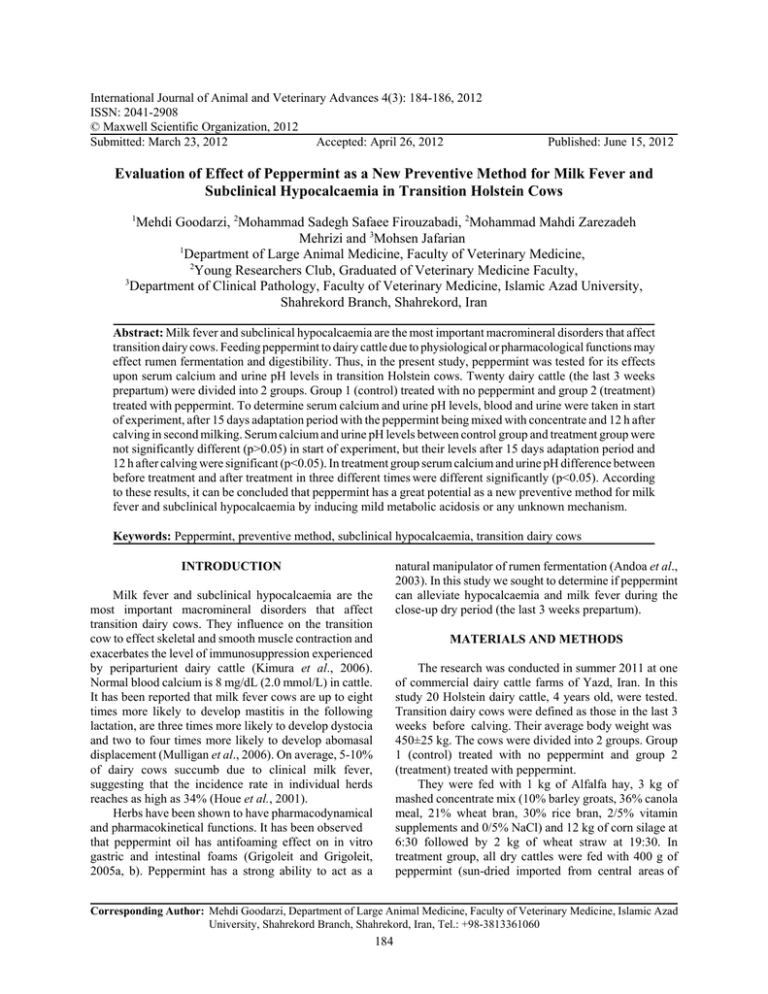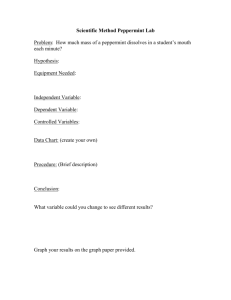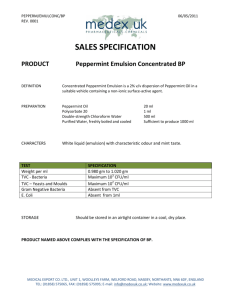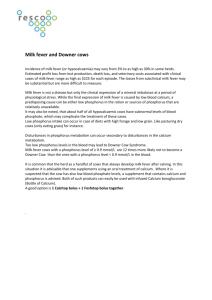International Journal of Animal and Veterinary Advances 4(3): 184-186, 2012
advertisement

International Journal of Animal and Veterinary Advances 4(3): 184-186, 2012 ISSN: 2041-2908 © Maxwell Scientific Organization, 2012 Submitted: March 23, 2012 Accepted: April 26, 2012 Published: June 15, 2012 Evaluation of Effect of Peppermint as a New Preventive Method for Milk Fever and Subclinical Hypocalcaemia in Transition Holstein Cows 1 Mehdi Goodarzi, 2Mohammad Sadegh Safaee Firouzabadi, 2Mohammad Mahdi Zarezadeh Mehrizi and 3Mohsen Jafarian 1 Department of Large Animal Medicine, Faculty of Veterinary Medicine, 2 Young Researchers Club, Graduated of Veterinary Medicine Faculty, 3 Department of Clinical Pathology, Faculty of Veterinary Medicine, Islamic Azad University, Shahrekord Branch, Shahrekord, Iran Abstract: Milk fever and subclinical hypocalcaemia are the most important macromineral disorders that affect transition dairy cows. Feeding peppermint to dairy cattle due to physiological or pharmacological functions may effect rumen fermentation and digestibility. Thus, in the present study, peppermint was tested for its effects upon serum calcium and urine pH levels in transition Holstein cows. Twenty dairy cattle (the last 3 weeks prepartum) were divided into 2 groups. Group 1 (control) treated with no peppermint and group 2 (treatment) treated with peppermint. To determine serum calcium and urine pH levels, blood and urine were taken in start of experiment, after 15 days adaptation period with the peppermint being mixed with concentrate and 12 h after calving in second milking. Serum calcium and urine pH levels between control group and treatment group were not significantly different (p>0.05) in start of experiment, but their levels after 15 days adaptation period and 12 h after calving were significant (p<0.05). In treatment group serum calcium and urine pH difference between before treatment and after treatment in three different times were different significantly (p<0.05). According to these results, it can be concluded that peppermint has a great potential as a new preventive method for milk fever and subclinical hypocalcaemia by inducing mild metabolic acidosis or any unknown mechanism. Keywords: Peppermint, preventive method, subclinical hypocalcaemia, transition dairy cows natural manipulator of rumen fermentation (Andoa et al., 2003). In this study we sought to determine if peppermint can alleviate hypocalcaemia and milk fever during the close-up dry period (the last 3 weeks prepartum). INTRODUCTION Milk fever and subclinical hypocalcaemia are the most important macromineral disorders that affect transition dairy cows. They influence on the transition cow to effect skeletal and smooth muscle contraction and exacerbates the level of immunosuppression experienced by periparturient dairy cattle (Kimura et al., 2006). Normal blood calcium is 8 mg/dL (2.0 mmol/L) in cattle. It has been reported that milk fever cows are up to eight times more likely to develop mastitis in the following lactation, are three times more likely to develop dystocia and two to four times more likely to develop abomasal displacement (Mulligan et al., 2006). On average, 5-10% of dairy cows succumb due to clinical milk fever, suggesting that the incidence rate in individual herds reaches as high as 34% (Houe et al., 2001). Herbs have been shown to have pharmacodynamical and pharmacokinetical functions. It has been observed that peppermint oil has antifoaming effect on in vitro gastric and intestinal foams (Grigoleit and Grigoleit, 2005a, b). Peppermint has a strong ability to act as a MATERIALS AND METHODS The research was conducted in summer 2011 at one of commercial dairy cattle farms of Yazd, Iran. In this study 20 Holstein dairy cattle, 4 years old, were tested. Transition dairy cows were defined as those in the last 3 weeks before calving. Their average body weight was 450±25 kg. The cows were divided into 2 groups. Group 1 (control) treated with no peppermint and group 2 (treatment) treated with peppermint. They were fed with 1 kg of Alfalfa hay, 3 kg of mashed concentrate mix (10% barley groats, 36% canola meal, 21% wheat bran, 30% rice bran, 2/5% vitamin supplements and 0/5% NaCl) and 12 kg of corn silage at 6:30 followed by 2 kg of wheat straw at 19:30. In treatment group, all dry cattles were fed with 400 g of peppermint (sun-dried imported from central areas of Corresponding Author: Mehdi Goodarzi, Department of Large Animal Medicine, Faculty of Veterinary Medicine, Islamic Azad University, Shahrekord Branch, Shahrekord, Iran, Tel.: +98-3813361060 184 Int. J. Anim. Veter. Adv., 4(3): 184-186, 2012 Table 1: Macromineral analysis of peppermint Description Sodium Potassium Calcium Chloride Sulfur Iran) daily that was mixed with mashed concentrate. Water provided ad libitum. Macromineral analysis of sodium, potassium, chloride, sulfur and calcium of peppermint were measured using Wet chemistry methods. To calculate Dietary Cation Anion Balance (DCAB) in milli-equivalents per 100 g of ration of dry matter for a peppermint, the following formula was used: [(% sodium/0.023) + (% potassium/0.039)] – [(% chloride/0.0355) + (% sulfur/0.016)] (Moore et al., 1997). Ten mL of blood was taken from jugular vein of each cattle in three different times: in start of experiment (Ca1), after 15 days adaptation period with the peppermint being mixed with concentrate (Ca2) and 12 h after calving (Ca3) in second milking. Serum was separated and the level of calcium was determined spectrophotometrically at 550 nm (Jadhav et al., 2010). The urine pH of all cows determined at three different times similar to blood sampling. Urine pH was measured by digital pH-meter from fresh urine in middle part of urination. Percent (%) 1.90 1.60 2.40 3.25 0.60 Table 2: The average of blood calcium levels (mg/dL) different times Ca2 Ca1 Control 8.81±0.07 8.54±0.04 Treatment 8.94±0.07 9.53±0.04* Results are shown as mean±S.D; *: p<0.05 in the three Ca3 7.51±0.16 8.43±0.03* Table 3: The average of urine pH levels in the three different times pH2 pH3 pH1 Control 6.86±0.07 6.89±0.07 6.80±0.07 Treatment 6.83±0.07 6.04±0.07* 6.47±0.07* Results are shown as mean±S.D; *: p<0.05 significantly different (p>0.05), urine pH levels in treatment group after 15 days adaptation period (pH2) and 12 h after calving (pH3) were significantly lower than in the control group (p<0.05) at similar times. In treatment group the difference between before treatment and after treatment in three different times (pH1, pH2 and pH3) were different significantly (p<0.05). In control group the average of urine pH levels in all of times (pH1, pH2 and pH3) was not different significantly (p>0.05). RESULTS Table 1 shows the macromineral analysis for peppermint. For calculation DCAB of peppermint in a feed were used this following: DISCUSSION % constant milliequivalents: Na 1.90% 0.023 = + 83 K 1.60% 0.039 = + 41 S 0.6% 0.016 = – 37/5 Cl 3.25% 0.0355 = – 91/5 Optimum urine pH for close-up dry cows is about 5.5 to 6.5 (Davidson et al., 1995). In this experiment, the average of urine pH levels in peppermint-fed cattles shows peppermint can induce mild metabolic acidosis and normal blood calcium by a negative DCAB or any unknown mechanism. Metabolic acidosis increases tissue response to parathyroid hormone and lead to increase calcium resorption from bone; also parathyroid hormone receptors in bone are less functional at high blood pH (Horst et al., 1997). The most common strategy employed to achieve this negative DCAB is the addition of anionic salts to the diet of pre-calving cattle (Goff, 2004). Anionic salts are expensive, significantly increasing feed costs per day for the close-up group. They are unpalatable and can reduce dry matter intake. Significant reductions in dry matter intake near parturition can predispose animals to metabolic disorders such as milk fever, displaced abomasum and ketosis (Moore et al., 1997) but Ando et al. (2003) reported that ruminal pH was significantly lower in the peppermint-fed steers than in the control steers and Peppermint feeding had no adverse effects upon ruminal fermentation and nutrient digestibility. Also Total cation milliequivalents/100 g = 83 + 41 = +124 Total anion milliequivalents/100 g = 37/5 + 91/5 = –129 Cation-anion difference = 124 – 129 = – 5 Table 2 shows the average of blood calcium levels in the three different times. Although in start of the study the calcium levels (Ca1) between control group and treatment group was not significantly different (p>0.05), blood calcium levels in treatment group after 15 days adaptation period (Ca2) and 12 h after calving (Ca3) was significantly higher than that of the control group (p<0.05). Also, in control and treatment groups the differences between the level of calcium before and after treatment in three different times (Ca1, Ca2 and Ca3) were significant (p<0.05). Table 3 shows the average of urine pH levels in the three different times. pH levels between control group and treatment group in start of experiment (pH1) was not 185 Int. J. Anim. Veter. Adv., 4(3): 184-186, 2012 antispasmodic and antifoaming effects of peppermint oil may play an additional role to induce a good palatability (Grigoleit and Grigoleit, 2005a, b). Peppermint similar to alfalfa is high in calcium but one of the classical strategies often proposed for milk fever prevention is the restriction of calcium intake precalving. This strategy is not a practical alternative for milk fever prevention on farms using grass or grass silage as a large component of the dry-cow diet (Wilson, 2001). Grigoleit, H.G. and P. Grigoleit, 2005a. Pharmacology and preclinical pharmacokinetics of peppermint oil. J. Phytomed., 12: 612-616. Grigoleit, H.G. and P. Grigoleit, 2005b. Gastrointestinal clinical pharmacology of peppermint oil. J. Phytomed., 12: 607-611. Horst, R.L., J.P. Goff, T.A. Reinhardt and D.R. Buxton, 1997. Strategies for preventing milk fever in dairy cattle. J. Dairy Sci., 80: 1269. Houe, H., S. Ostergaard, T. Thilsing-Hansen, R.J. Jorgensen, T. Larsen, J.T. Sorensen, J.F. Agger and J.Y. Blom, 2001. Milk fever and subclinical hypocalcaemia-an evaluation of parameters on incidence risk, diagnosis, risk factorsand biological effects as input for a decision support system for disease control. Acta Vet. Scand., 42: 1-29. Jadhav, S.D., M.S. Bhatia, S.L. Thamake and S.A. Pishawikar, 2010. Spectrophotometric methods for estimation of atorvastatin calcium form tablet dosage forms. Int. J. Pharm. Tech. Res., 2(3): 1948-1953. Kimura, K., T.A. Reinhardt and J.P. Goff, 2006. Parturition and hypocalcaemia blunts calcium signals and immune cells of dairy cattle. J. Dairy Sci., 89: 2588-2595. Moore, S.J., M.J. VandeHaar, B.K. Sharma, T.E. Pilbeam, D.K. Beede, H.F. Bucholtz, J.S. Liesman, R.L. Horst and J.P. Goff, 1997. Varying Dietarycation Anion Difference (DCAD) for dairy cattle before calving. J. Dairy Sci., 1: 170. Mulligan, F., L. O’Grady, D. Rice and M. Doherty, 2006. Production diseases of the transition cow: Milk fever and subclinical hypocalcaemia. Irish V. J., 59: 697-702. Wilson, G.F., 2001. A novel nutritional strategy to prevent milk fever and stimulate milk production in dairy cows. N.Z. Vet. J., 49(2): 78-80. CONCLUSION Peppermint feeding by inducing mild metabolic acidosis and normal blood calcium can be a new preventive method for milk fever and subclinical hypocalcaemia in transition Holstein cows. This method can be better than other preventive strategies such as addition of anionic salts to the diet and calcium restriction; because of tow-reasons: First, peppermint is cheap, significantly decreasing feed costs per day for the close-up group. Second, it’s no adverse effects upon ruminal fermentation and nutrient digestibility. ACKNOWLEDGMENT This study has been supported financially by Islamic Azad University, Shahrekord Branch, Iran. REFERENCES Andoa, S., T. Nishidab, M. Ishidab, K. Hosodab and E. Bayarub, 2003. Effect of peppermint feeding on the digestibility, ruminal fermentation and protozoa. Livestock Prod. Sci., 82: 245-248. Davidson, J., L. Rodriguez, T. Pilbeam and D. Beede, 1995. Urine pH check helps avoid milk fever. Hoard’s Dairyman, 140(16): 634. Goff, J.P., 2004. Macromineral disorders of the transition cow. Vet. Clin. North Am. Food Anim. Pract., 20: 471-494. 186






